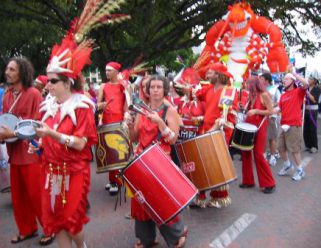

The following applies to the type of samba done during street carnivals where the musicians will move along with the dancers, sometimes on foot, sometimes on a motorized 'float' or platform. Thus, common step values (in beats are): 3/4 Samba is notable for its constantly changing rhythms however, with cross-rhythms being a common feature. This action is created through the bending and straightening of the knees, with bending occurring on the beats of 1 and 2, and the straightening occurring on the "a". The basic movements are counted either 1-2 or 1-a-2, and are danced with a slight bouncing action. The ballroom samba is danced to music in 2/4 time. The dance movements, which do not change depending on the style of samba music being played, borrows some movements from Afro-Brazilian traditional dances such those used in candomblé rituals. Styleīallroom samba, like other ballroom dances, is a form adapted for its suitability as a partner dance. This version is now danced all over the world in international competitive dancing as regulated by the World Dance Council. The modern ballroom dance was created in England, mostly with steps adapted from those seen in Brazil.
#SAMBA STREET DANCE HOW TO#
A book published in France in 1928 already described how to perform the samba. Many steps can be traced back to the Maxixe danced in 1910s. The ballroom samba has its origins in Brazil at the beginning of the 20th century. In that case, the dancers take just one step on each beat. Traditional Brazilian samba includes the samba which is danced solo at Carnival. Joan Hamby Burroughs, the Alabama Jazz Hall of Fame and organizers of the Selma Bridge Crossing.There are two main types of samba that differ from each other: the modern ballroom samba, and the traditional samba of Brazil. In 2018, Samba in the Streets will travel to Birmingham and Selma, Alabama in collaboration with dance anthropologist, Dr. Samba in the Streets is a Viver Brasil community engagement program in partnership with KAOS Network made possible in part by a grant from the City of Los Angeles, Department of Cultural Affairs, California Arts Council and Engaging Dance Audiences that is administered by Dance/USA and made possible with generous funding from the Doris Duke Charitable Foundation. If you have your own drum, please bring it! Samba in the Streets participants will have the wonderful opportunity to parade in a Bahian Bloco Afro procession on JUNE 25 & JULY 30 in conjunction with Leimert Park Art Walk!ĭrums will be provided throughout the program.
#SAMBA STREET DANCE FREE#
All classes are free and open to the public! Samba in the Streets teaches Afro-Brazilian dance and its accompanying drum rhythms to create joyful movement and music community dance experiences in community centers, neighborhood plazas and other public spaces. The workshops teach participants Afro-Brazilian traditional dances and are modeled on Blocos Afro, Afro-Brazilian parading organizations that introduce communities to Afro-Brazilian history through traditional and contemporary dance and music.ĥ:30-7pm - adult class (ages 14 + adults and seniors)Ĥ-6 pm - adult and teen (ages 14 + adults and seniors) Experience the joy of Afro-Brazilian dance, drumming and song.


 0 kommentar(er)
0 kommentar(er)
